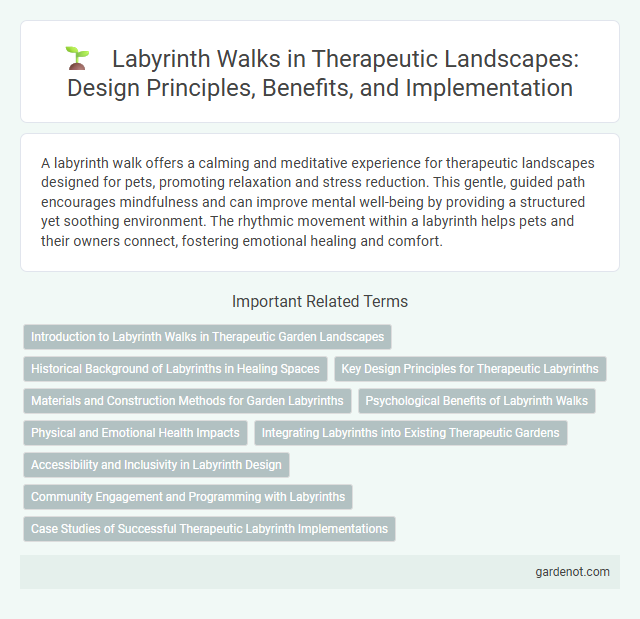A labyrinth walk offers a calming and meditative experience for therapeutic landscapes designed for pets, promoting relaxation and stress reduction. This gentle, guided path encourages mindfulness and can improve mental well-being by providing a structured yet soothing environment. The rhythmic movement within a labyrinth helps pets and their owners connect, fostering emotional healing and comfort.
Introduction to Labyrinth Walks in Therapeutic Garden Landscapes
Labyrinth walks in therapeutic garden landscapes offer a unique form of contemplative movement designed to promote mental clarity and emotional healing. These intricate pathways encourage mindfulness through slow, deliberate walking, fostering stress reduction and enhancing cognitive focus. Incorporating labyrinths into garden designs creates immersive experiences that support psychological well-being and spiritual reflection.
Historical Background of Labyrinths in Healing Spaces
Labyrinths have been integral to therapeutic landscapes for thousands of years, with origins tracing back to ancient civilizations such as the Greeks, Egyptians, and Native Americans. Historically, labyrinths were used as healing tools in spiritual and ritualistic practices, symbolizing a journey toward inner peace and mindfulness. Their design and use in healing spaces have evolved, merging ancient symbolism with modern therapeutic techniques to promote mental and emotional well-being.
Key Design Principles for Therapeutic Labyrinths
Therapeutic labyrinths prioritize clear pathways and symmetrical design to facilitate mindfulness and stress reduction. Incorporating natural materials and sensory elements such as textured stones and surrounding greenery enhances the healing experience by engaging multiple senses. Path width and curve frequency are optimized to encourage slow, meditative walking and promote psychological restoration.
Materials and Construction Methods for Garden Labyrinths
Garden labyrinths are typically constructed using natural materials such as flagstones, gravel, or packed earth to create durable and visually appealing pathways. Construction methods often involve careful site selection to ensure proper drainage, followed by precise layout using templates or string lines to maintain symmetrical and intricate labyrinth designs. Incorporating native plants and organic edging materials enhances the therapeutic landscape by providing a harmonious and calming environment for mindful walking.
Psychological Benefits of Labyrinth Walks
Labyrinth walks promote mindfulness by guiding participants through a meditative path that reduces stress and anxiety while enhancing mental clarity. Engaging in this rhythmic, purposeful movement stimulates relaxation and emotional balance, supporting psychological resilience. Research highlights that labyrinth walking facilitates introspection and improves focus, contributing to overall cognitive well-being.
Physical and Emotional Health Impacts
Labyrinth walks promote physical health by encouraging gentle, mindful movement that enhances balance, coordination, and cardiovascular function. Emotionally, the slow, deliberate pace fosters stress reduction, mindfulness, and emotional clarity, aiding in anxiety and depression management. This therapeutic landscape element integrates body-mind connection, supporting overall well-being through meditative walking.
Integrating Labyrinths into Existing Therapeutic Gardens
Integrating labyrinths into existing therapeutic gardens enhances mindfulness and stress reduction through guided walking paths that promote meditative reflection. These labyrinths provide structured movement patterns encouraging patients to engage sensory experiences, which supports emotional healing and mental clarity. Therapeutic garden designs incorporating labyrinths often prioritize accessibility and natural elements to maximize restorative benefits.
Accessibility and Inclusivity in Labyrinth Design
Labyrinth walks incorporate universal design principles to ensure accessibility for individuals with diverse mobility needs, including wider paths, smooth surfaces, and gentle gradients. Inclusive labyrinth design considers sensory elements such as tactile paving and auditory cues to accommodate people with visual or cognitive impairments. These features promote therapeutic benefits by enabling all users to engage safely and meaningfully with the healing environment.
Community Engagement and Programming with Labyrinths
Labyrinth walks foster community engagement by creating inclusive spaces where individuals participate in shared therapeutic experiences. Programming with labyrinths often includes guided meditation sessions, workshops, and group walks that enhance mindfulness and social connection. These activities promote mental well-being, encourage local cultural expression, and strengthen community bonds through collective healing practices.
Case Studies of Successful Therapeutic Labyrinth Implementations
Case studies of successful therapeutic labyrinth implementations reveal significant improvements in mental well-being and stress reduction among participants. Facilities such as hospitals, rehabilitation centers, and mental health clinics report enhanced patient outcomes through guided labyrinth walks that promote mindfulness and emotional healing. Research highlights the effectiveness of these labyrinths in reducing anxiety, improving focus, and fostering a sense of calm in diverse therapeutic settings.
Labyrinth walk Infographic

 gardenot.com
gardenot.com